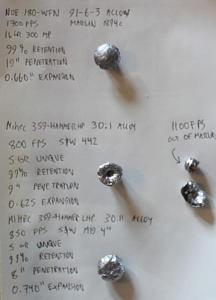Gel calibrated 3.5" with 17 caliber BB at 590 FPS--within spec.
4 layers of denim.
This is the first promising 38 Special load I've found that will work in a subnose revolver. It isn't running even at +p pressures probably being just 5 grains of Unique pushing a 159 grain MP-molds 359 Hammer bullet with the large hollowpoint cast of 30:1 pb-sn.
Even at 800 FPS this expanded impressively to over 0.6" and but penetrated to only 9" with 99% retained weight. Add another 50 FPS (when fired from my Model 19) it penetrated an inch less but expanded to nearly three quarters inch!
The relationship between velocity and depth is becoming clearer, and it seems that 38 Special just doesn't have the gas needed to get to the 12" depth IF you want impressive expansion. I am going to try the same load with the soft 30:1 allow and the small HP cavity (bullet weight 162-163) and see if it will reduce the expansion and make a foot of penetration.
The other test was of the NOE 360-182-WFNGC bullet cast of 91-6-3 (pb-sn-sb) launched by 16 grains of 300 MP. Observations were that this is a mild shooting load with no pressure signs, it cycles perfectly, and gets 1700 FPS out of my Marlin 1894C. Performance was quite good with over .6" expansion and a solid 19" of penetration with 99% retained weight and very impressive smack--the initial "stretch" cavity. It blew the gel off the table and cracked the clay brick it was sitting on! Though it was not as shocking as the 158 grain Hornady XTPFP launched at 1900 FPS!


|
   
   
|


|



 Reply With Quote
Reply With Quote












